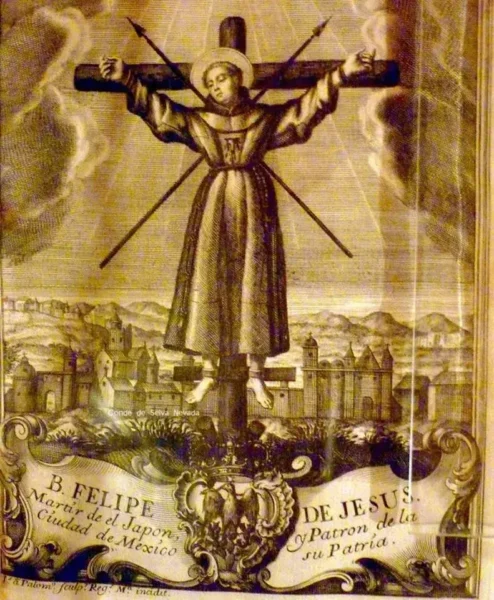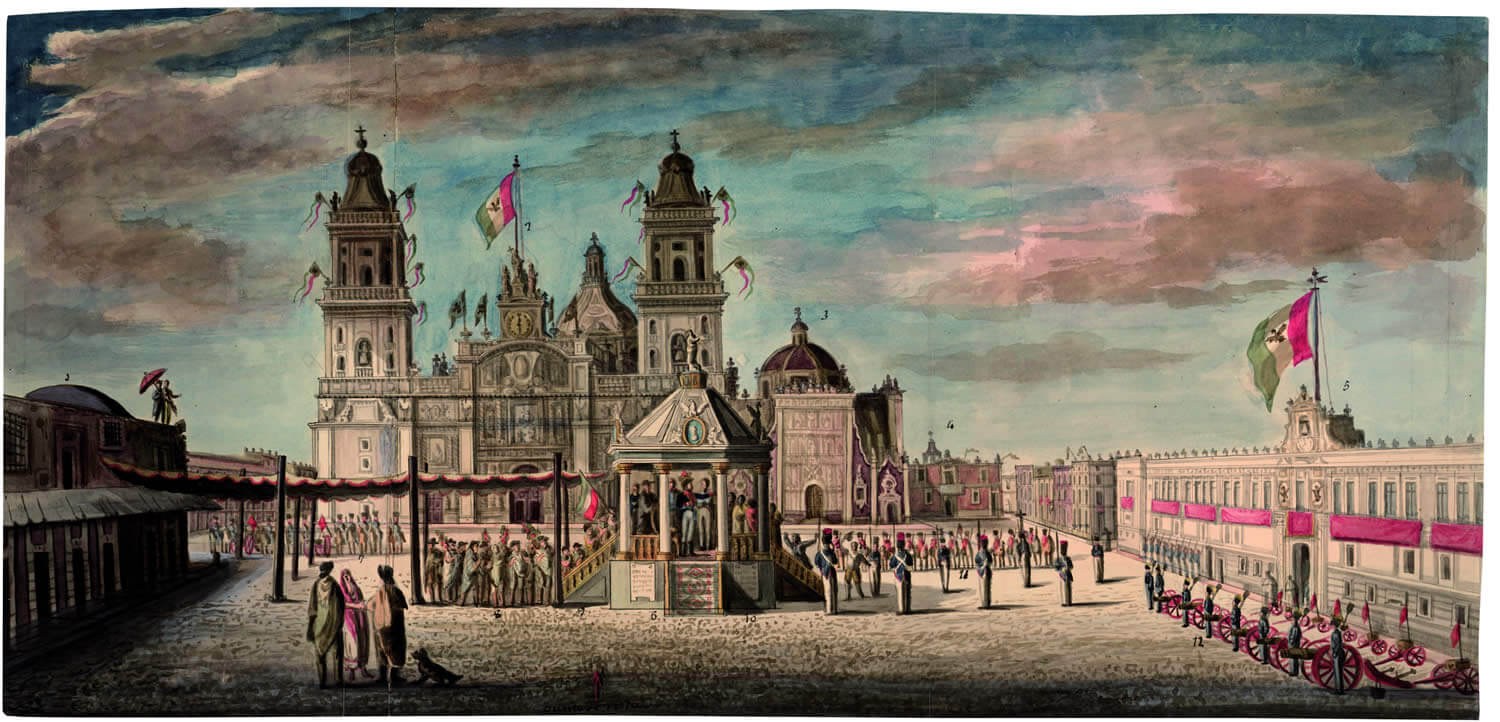Above: Plaza Mayor de México (today Plaza del Zócalo), 1830 by Theubet de Beauchamp, showing the Mexico City Cathedral where San Felipe was baptised.
On May 13, 1524, twelve Franciscan friars from Spain set foot on Mexican soil for the first time. The evangelization of Mexico had begun!
According to Robert Ricard in The Spiritual Conquest of Mexico, this “sweeping wave of evangelization was one of the great glories of the 16th century… Missions sprang up everywhere.”
After the Spanish conquest of the Aztecs in 1521 the Franciscan Order was chosen to bring the Catholic faith to the new lands. “They were the kingpins of the young Mexican church!” said Ricard. Dominicans, Augustinians, and Jesuits would follow. But the Franciscans were the first.
Cortés chose this order because of the exemplary holiness of their lives. Historians spoke of the “eminent virtues” of so many of the founders of the church in New Spain. In 1545 Bishop Juan de Zumarraga wrote about the “extreme humbleness of the Franciscan convent in Mexico City.” “The religious there lived in the greatest poverty,” he said. He recalled that the Indians marvelled at the friars, especially “at their scorn of the gold and silver to which the Spanish laymen gave such value.”
Is it any wonder that so many Indians converted to the Christian faith? The Aztecs embraced human sacrifice on a horrific scale. At the inauguration of the temple of Tlaltelolco in 1487, for example, 20,000 warriors were sacrificed on its altars at the command of the Aztec emperor. The serpent-god Huitzilopochtli was insatiable in his demands for such sacrifice.
After the miraculous appearance of Our Lady of Guadalupe in 1531 at Tepeyac Hill in Mexico City human sacrifice was abolished in the country. Conversions to the faith on a scale “perhaps unprecedented in human history” occurred. Within a decade more than nine million Aztecs became Christian. “Churches, monasteries, convents, hospitals, schools, and workshops sprang up all over the country in the wake of this phenomenal missionary conquest.” For who could resist this message of maternal love from Our Lady? “I am your merciful Mother – Am I not here who am your Mother? Are you not under my shadow and protection? Is there anything else you need?” Furthermore, she appeared as La Morenita, the dark-skinned one. She was one of them!
This was the vibrant religious atmosphere that surrounded two pious new arrivals from Spain, Alonso de las Casas and Antonia Ruiz Martinez. They were just a young couple when they travelled from Salamanca in October of 1571. They marvelled at the splendour and magnificence of Mexico City. Alonso was talented and enterprising and realized that he had come to a land of opportunity. On May 1, 1572, the first of their children was born. He was baptized in the great Cathedral of Mexico City. They named him Felipe.
Each year the fortunes of the father grew exponentially. “This is the best place in the world to be!” enthused Alonso. This affluence affected the boy. He became proud of his opulent wardrobe, of his spirited horses! And Felipe became more irresponsible and restless by the day. Only the tears of his mother moved him. “Felipillo!” she implored, “Become a saint!”
The boy had other ideas, however. When he was 13 his father took him to the port of Acapulco. He was thrilled to see so many merchant ships from the exotic Orient: Japan, China and the Philippines! He loved listening to the “fabulous” stories of the sailors best of all. “Oh, the places I will go!” he thought. How he dreamed!
To everyone’s surprise, however, the teenager had a sudden change of heart: “I want to become a friar!” he said. With that in mind he arrived at the Reformed Franciscan Convent of Santa Barbara in Puebla. Sadly, his zeal did not last. After a few months he left the order and embarked on a merchant career. In 1591, his wealthy father gave him a substantial amount of money to set sail for the Philippines to embark upon a business venture. In Manila he led a most hedonistic lifestyle, far from God.
Our Lord intervened. While there his heart was deeply touched to the core, and, “sobbing and repentant,” he joined the Franciscan friary of Santa Maria de los Angeles in Manila under the direction of Novice Master friar Vincent Valero. The 21-year-old was admitted to the friary on May 21, 1593. He had chosen a particularly severe order, a group of discalced friars who “embraced strictness in dress, work and prayer.” A Franciscan friary in the Philippines? Yes: In 1576 King Philip ll of Spain appointed the Franciscan Order to be the evangelizers of the country.
After several years of seminary formation his superiors decided he was ready for ordination. There was only one problem: there was no bishop in the country at the time. Thus it was that the Franciscan superiors made the fateful decision to send him back to Mexico for his ordination.
On July 12, 1596, he and several friars left Manila and set sail on the Spanish galleon (ironically called San Felipe) for Acapulco, Mexico. The ship was blown off course by a typhoon and was shipwrecked off the coast of Japan. San Felipe and his Franciscan companions were taken prisoner.
Only a few years earlier, in 1549, Jesuit priest St. Francis Xavier and two other Jesuits waded ashore onto the Japanese coast. They were the first missionaries in the country and met with extraordinary success. Nearly half a million Buddhists converted to the Catholic faith.
Circumstances changed later for all Catholics in the country, however: in 1597 the Catholic faith was banned and all religious in Osaka and Kyoto were to be rounded up and killed. A total of twenty-six Catholics would soon be crucified and martyred for their faith. They would become known as the Twenty-Six Martyrs of Nagasaki. One hundred and thirty Catholic churches would be burned as well.
San Felipe was one of these martyrs. He and the others were tortured and mutilated (their ears and noses were cut off) and were paraded in oxcarts through the cities of Kyoto, Osaka and Sakai. Father Paul Miki, S.J., one of the best known of these martyrs, and considered to be the most eloquent preacher in Japan, preached passionately during his via crucis. The three youngest catechists (the youngest was only twelve) kept singing out the Our Father and the Hail Mary.
On Jan. 9, the martyrs began their brutal forced march (a journey of 27 days) to the city of Nagasaki where their crosses awaited them. The road to Nagasaki was lined with Christians who joined in with the martyrs in praising God and singing hymns. There were many eyewitnesses to the shocking events. As the crucifixions began, both the martyrs and the crowd began chanting Jesus! Maria! Jesus! Maria! Jesus! Maria! The date was Feb. 5, 1597.
When it was San Felipe’s turn he clasped his cross and cried out in a loud voice:
“O happy ship! O happy galleon for Philip! Lost for my gain – no loss for me but the greatest of all gain!” All the while repeating the Holy Name of Jesus.

During the savage Cristero War in Mexico (1926-1929), it is said that every Cristero soldier carried a picture of San Felipe close to his heart. He was their very own hero. He was one of them! And they recognized, of course, that they and San Felipe were both fighting against the same enemy.
Epilogue
In the 1950s San Felipe came to prominence once more in the country and in the most surprising manner: the year was 1957. Workmen were busy renovating the interior of the 16th century Cathedral of Cuernavaca when they came across something astonishing: under layers of dirt, grime and whitewash they discovered artistic treasures – frescoes from the 1600s, painted on the original walls of the church. As the renovation progressed “the scale and extent of the murals astounded the excited researchers.” This caused a sensation in the country.
What did these “magnificent” murals depict? They told the story of the twenty-six martyrs of Japan. The revelation created “almost a national shrine to San Felipe.” The enormous frescoes – almost 75 ft. long and 25 ft. high – were painted between 1628 and 1697. They depicted the death of the martyrs in harrowing detail. Says one author: “We see San Felipe’s arrival on the shores of Japan, the journey by boat and cart to the place of execution and finally his crucifixion.”


Felipe was beatified on Sept. 14, 1627 and canonized on June 8, 1862 by Pope Pius IX. A temple was built in his honour in 1886 in the historical centre of Mexico City. He is the city’s official patron.
His feast day is today: Feb. 5.
Sources
Mexico’s Fortress Monasteries by Richard Perry
Our Lady of Guadalupe by Carl Anderson and Eduardo Chavez
The Wonder of Guadalupe by Francis Johnston
Spiritual Conquest of Mexico by Robert Ricard
Booklets from the churches mentioned


